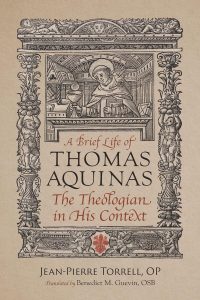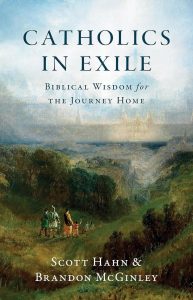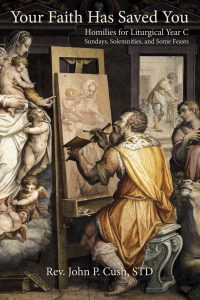A Brief Life of Thomas Aquinas: The Theologian in His Context. By Jean-Pierre Torrell, OP. Reviewed by Rev. Ryan Connors. (skip to review)
Catholics in Exile: Biblical Wisdom for the Journey Home. By Scott Hahn and Brandon McGinley. Reviewed by Marc Tumeinski. (skip to review)
Your Faith Has Saved You: Homilies for Liturgical Year C–Sundays, Solemnities, and Some Feasts. By Rev. John P. Cush. Reviewed by Fr. Denis Nakkeeran. (skip to review)
Remnant of Paradise: Selected Essays. By Alice von Hildebrand; ed. by John Henry Crosby. Reviewed by K.E. Colombini. (skip to review)
A Brief Life of Thomas Aquinas – Jean-Pierre Torrell, OP
Torrell, Jean-Pierre, OP. A Brief Life of Thomas Aquinas: The Theologian in His Context, trans. Benedict M. Guevin, OSB. Washington, DC: The Catholic University of America Press, 2024. 192 pages.
Reviewed by Rev. Ryan Connors.
 Longtime professor at the Swiss University of Fribourg, Dominican Father Jean-Pierre Torrell has been called the greatest living Thomist. He holds the distinction of being one of the few living theologians quoted in a contemporary papal address. When the scholarly pontiff Pope Benedict XVI set out to teach on the life and teaching of St. Thomas Aquinas, he quoted Father Torrell (more than once)! (See Pope Benedict XVI, Wednesday audiences, 2 June 2010 and 23 June 2010).
Longtime professor at the Swiss University of Fribourg, Dominican Father Jean-Pierre Torrell has been called the greatest living Thomist. He holds the distinction of being one of the few living theologians quoted in a contemporary papal address. When the scholarly pontiff Pope Benedict XVI set out to teach on the life and teaching of St. Thomas Aquinas, he quoted Father Torrell (more than once)! (See Pope Benedict XVI, Wednesday audiences, 2 June 2010 and 23 June 2010).
Torrell’s two volumes, Saint Thomas Aquinas. Vol. 1, The Person and His Work, Third Edition trans. Matthew K. Minerd and Robert Royal (Washington, DC: The Catholic University of America Press, 2023) and Saint Thomas Aquinas. Vol. 2, Spiritual Master, trans. Robert Royal (Washington, DC: The Catholic University of America Press, 2003) remain the magisterial presentation of the life and teaching of the Church’s common doctor. With his latest, A Brief Life of Thomas Aquinas, Torrell offers the Church and the world an accessible and, it must be said, even simple introduction to the man and the Saint.
The American Benedictine Benedict Guevin offers a delightful translation that is both easy to read and, at the same time, precise in expression. Like Robert Royal, Bernhard Blankenhorn, OP, Matthew Minerd and others, Father Guevin has brought Father Torrell to be known and appreciated by the Anglophone world. English-speakers the world over stand in their debt.
The book unfolds in thirteen chapters. The author reveals aspects of Aquinas’s character and teaching by means of a review of his books. The text under review presents itself as a kind of literary biography, taking seriously, as St. Thomas did, the importance of his scholarly output. Torrell offers summaries of Aquinas’s biblical commentaries (with special attention to the Commentary on St. John’s Gospel [Torrell, 103]), his philosophical commentaries, as well as the Summa contra gentiles and Summa theologiae. The descriptions of these texts never appear dry, however, as the author’s aim is to express the character of the Saint and the grace he introduced into the world.
While an obedient religious, Aquinas was not a slave to the cloister. We learn that St. Thomas traveled “some ten thousand kilometers, most of the time on foot” (45). We learn too of his “legendarily difficult” handwriting (43). Torrell’s description of Aquinas’s Against the Enemies of the Worship of God and the Religious State allows him to describe St. Thomas’s teaching on the perfection of religious life and especially of the contemplative who would bring to others “the truths [he] has contemplated” (40).
Along the way, we discover aspects of Aquinas personality. For example, despite his family’s opposition to his Dominican vocation, he remained close to them and “did not hold a grudge” (6). Discussion of the Catena Aurea offers the occasion to present Thomas’s knowledge of the Greek Fathers, largely unknown in the West. He quotes them accurately and with attribution, not the custom of the time (64). Torrell quotes his fellow Fribourg Dominican the late Ceslas Spicq (1901–1992) in his remark that the Catena is a “mine for exegetes, theologians, and preachers” (65).
The Commentary on Job presents St. Thomas with the occasion to discuss divine providence. He begins with God’s providence of the natural world. Torrell offers moving reflections on Aquinas’s Eucharistic hymns, especially an extended treatment of the Adoro Te devote (67–68). In Orvieto at the Papal Court, we find St. Thomas at work for the Church. So many of his writings from this period were occasioned at the request of others, especially of ecclesiastical superiors.
One episode from Aquinas’s life that is often misunderstood occurred near its end. On the feast of St. Nicholas 1273, Aquinas experienced a kind of ecstasy from which he was transformed. To a bewildered socius he explained that “Everything that I have written seems to be straw in comparison” (133). Torrell corrects the usual conclusion drawn from the oft-cited event. First off, even after this experience, Aquinas continued to work when he was asked to do so. His written reply to the Abbot of Monte Casino on the relationship between human freedom and divine government stands as one of his clearest in presentation (134). More basically, the point of the episode is not that the study of theology does not matter or that precision in thought is useless, but only that it all points to God Himself of whom Aquinas was granted a vision.
From October 1268 through April 1272 Aquinas composed some 4,061 pages. That total represents a daily output of 2403 words (114). He benefited from the assistance of up to four secretaries, although Torrell disputes the amusing description of Aquinas dictating to each at once. He explains that instead, they took turns during the day (115).
For those seeking an introduction to the life of the Church’s greatest doctor, they should look no further than this small book. Jean-Pierre Torrell remains the contemporary master of scholarship on the life and spiritual teaching of St. Thomas Aquinas. With this work, he has broadened the appeal of his already superb scholarship. The Catholic world stands in Father Torrell’s debt for this achievement.
Rev. Ryan Connors is a priest of the Diocese of Providence and Rector of the Seminary of Our Lady of Providence (Rhode Island). He is the author of Rethinking Cooperation with Evil: A Virtue-Based Approach (Washington, DC: The Catholic University of America Press, 2023); Moral Theology: An Introduction (Cape Girardeau, MO: ECT Press, 2025); and co-author with J. Brian Benestad of Church, State, and Society: An Introduction to Catholic Social Doctrine, Second Edition (Washington, DC, The Catholic University of America Press, 2025).
Catholics in Exile – Scott Hahn and Brandon McGinley
Hahn, Scott, and Brandon McGinley. Catholics in Exile: Biblical Wisdom for the Journey Home. Steubenville, OH: Emmaus Road Publishing, 2023. 181 pages.
Reviewed by Marc Tumeinski.
 I recommend this text as a good contemporary primer for Catholics on the idea of living in but not of the world. More specifically, Hahn and McGinley frame their book as an exploration of the question of how to “live amidst the ruins of a civilization based on the New Covenant” (5) while holding on to a Catholic vision for society (1). The authors point to multiple problems coming out of these “ruins,” such as envy leading to violence; structural sins; and political instability or at least political unease, confusion and uncertainty. The book addresses a topic of perennial relevance, namely, how do we live as disciples in light of the particular signs of the times. To get the most out of this book, I recommend pairing it with reading A Pilgrim People (2019) by Gerald Schlabach and/or William Cavanaugh’s 2011 Migrations of the Holy (especially chapters three, four and seven).
I recommend this text as a good contemporary primer for Catholics on the idea of living in but not of the world. More specifically, Hahn and McGinley frame their book as an exploration of the question of how to “live amidst the ruins of a civilization based on the New Covenant” (5) while holding on to a Catholic vision for society (1). The authors point to multiple problems coming out of these “ruins,” such as envy leading to violence; structural sins; and political instability or at least political unease, confusion and uncertainty. The book addresses a topic of perennial relevance, namely, how do we live as disciples in light of the particular signs of the times. To get the most out of this book, I recommend pairing it with reading A Pilgrim People (2019) by Gerald Schlabach and/or William Cavanaugh’s 2011 Migrations of the Holy (especially chapters three, four and seven).
In exploring the question of how Catholics are to live in today’s world, the authors focus on the “metaphors of . . . exile and pilgrimage and sojourning” (150). In other words, this world is not our home, though we are not “home-less,” and God is leading us on a pilgrimage to our true home. How are we to live in the meantime, in these seemingly unstable days? The authors offer multiple suggestions based on: trusting and rejoicing in the Lord; participating in the Mass and the sacraments; living our lives out of the gift of Sabbath rest (the focus of the final three chapters); cultivating hope and the virtue of longanimity; remaining open to glimpses of goodness from unexpected places and sources (including non-Christian ones); cleansing ourselves of idolatries of self, politics, consumerism, etc.; and “working for the good of our place of exile just as Jeremiah demanded” (101), which is the special focus of chapter four, “The Jeremiah Option.”
While the title about Catholics in exile could sound solely like a lament, this is not the primary message of the book. Instead, the authors invite readers to acknowledge the current social and political realities, but more importantly to reorient how we understand who we are and where we are in this world, in light of Revelation and Church teaching. The authors propose that, with divine grace and the belief that God is in control, we can be confident that our condition of exile is actually part of God’s plan of liberation. “This is the work of the Kingdom of God in this world. Through the limitless self-effusiveness of grace, a small and scattered people in exile can transform the world” (62). That understanding represents a dynamic invitation for the Church and disciples. It is consistent with Catholic social teaching as described in the Compendium of the Social Doctrine of the Church which begins with a charge to transform “social realities with the power of the Gospel.”
The book is clear and accessible. Its 15 chapters contain Biblical commentary as well as close reading of select theological texts. The authors share personal, cultural, literary, and historical illustrations of their key topics. The tone and content invite reflection and the book would serve as a good conversation starter for individual readers as well as for parish reading groups. As one would expect of any book involving Scott Hahn, it is rich with Scripture. The close reading and integration of various Scriptural texts (largely Old Testament though with some extended reading of Hebrews and 1 Peter) would, I imagine, suggest ideas and topics for homilies and catechetical lessons. More broadly, the authors draw also on Sacred Tradition and Church teaching. St. Augustine and St. John Henry Newman figure prominently, as well as the writings of Stefan Cardinal Wyszynski. Given the wealth of sources, an index or at least a list of sources would have been useful.
While Hahn and McGinley point out that God’s graces are given to the people of God undergoing exile, this focus on what living in exile means for the community as a whole would be worth fleshing out even more. This particular book was written in response to suggestions from readers of their previous book It Is Right and Just, so perhaps the authors would accept this suggestion to write a third volume exploring exile specifically in relation to the life of the parish as a community. At the very least, readers of this text may wish to think together as a parish about what the book means for their parish community.
A few gaps stood out. For instance, I found the thread of positive references to a desired return to a political Christendom at best puzzling and at other times distracting. The authors describe Christendom as “a civilization marked by the unity of the royal and priestly powers working together for the temporal and spiritual common good” and furthermore argue that Christendom “remains the goal” (63), while conceding that the “the possibility of integrated political and spiritual rule — the royal and priestly powers — is at least temporarily foreclosed” (60). Despite this last concession, though, I finished the book with a strong impression that the authors believe that Catholics should be working toward some kind of restored political Christendom. This kind of argumentation, while not prominent in every chapter, struck a sour note and somewhat undermined the core claim of the entire text. It also used a language that is not entirely consistent with contemporary Church teaching, for instance, in the teachings summarized in the Compendium of the Social Doctrine of the Church describing the relationship and the distinctions between the Church and the political community.
Given its 2023 publication date, the almost complete lack of references to Pope Francis (only one brief reference to Francis, compared with ten or more expansive references to Cardinal Ratzinger/Pope Benedict) is surprising, especially given the emphasis by Francis on pilgrims, pilgrimage and the Church’s pilgrim way for instance. Accordingly, I also recommend reading this text in dialogue with Francis (such as Evangelii gaudium) and now of course with Leo.
Overall, this text is well worth reading, keeping in mind some of the recommendations above for paired readings. I can envision this text leading to fruitful homilies and Bible studies, as well as to animated discussions within parishes, families and friendships. Such gifts are no small matter in today’s world.
Marc Tumeinski, Ph.D., is associate professor of theology at Anna Maria College (Paxton, Massachusetts).
Your Faith Has Saved You – Rev. John P. Cush
Cush, Rev. John P. Your Faith Has Saved You: Homilies for Liturgical Year C–Sundays, Solemnities, and Some Feasts. St. Louis, MO: En Route Books & Media, 2025. 293 pages.
Reviewed by Fr. Denis Nakkeeran.
 One of the great struggles for preachers of the Gospel is making present here and now the eternal and perennial truths found in Scripture. Many theories exist regarding the best approach to modern homiletics, such as finding the most immediately practical application of Jesus’s words or delving into the depths of Ignatian meditation. While no one method is perfect in every circumstance, there is always one thread that holds for preaching: Scripture reveals truth to us and we ought to let that truth shape our lives. Fr. John Cush communicates this point well in his book Your Faith Has Saved You, in the way that he shows the richness that can be offered in the Gospel as well as the richness that can be offered in liturgical preaching.
One of the great struggles for preachers of the Gospel is making present here and now the eternal and perennial truths found in Scripture. Many theories exist regarding the best approach to modern homiletics, such as finding the most immediately practical application of Jesus’s words or delving into the depths of Ignatian meditation. While no one method is perfect in every circumstance, there is always one thread that holds for preaching: Scripture reveals truth to us and we ought to let that truth shape our lives. Fr. John Cush communicates this point well in his book Your Faith Has Saved You, in the way that he shows the richness that can be offered in the Gospel as well as the richness that can be offered in liturgical preaching.
Cush does not structure his book as a book on homiletics. It is not a “how-to” for preachers nor does it offer an exposition on the nature of homiletics. Instead, he simply demonstrates good elements of preaching in the homilies that he has written and presented in this book. This book is best read as a source of good homilies in and of themselves, which can also serve as a model for the various techniques that can be employed in the preparation of one’s own homilies.
Cush focuses his work on the Gospel according to St. Luke, from which we find the majority of the Gospel readings within Year C of the liturgical cycle of Mass readings. Cush begins his book by offering a synopsis of the major Christological and narrative elements that comprise Luke’s Gospel, thus providing a significant anchor to ground any preacher in the theological nature of the Gospel. As Cush says, “The Christology of the Gospel of Luke offers a portrait of Jesus as the compassionate, universal, and Spirit-filled Savior. Patristic, medieval, and modern commentaries reveal how Luke’s narrative invites believers to encounter Christ, who bridges the human and divine, offering salvation to all.” (p. 4–5). If Luke wants to communicate Jesus Himself, through His words and deeds, then that should be the task of the preacher as well.
One characteristic that is already notable of these introductory notes is the good utilization and integration of various theological sources from across all of the history of Christianity. With the benefit of two thousand years of biblical commentaries, sermons, and a myriad of other sources that expound on the infinite treasure found in the Gospel, we can find many aids to help us understand the Gospel and preach on it. Through Cush’s careful research, the reader is introduced to the countless theological resources that exist, both ancient and modern, that can help one know Jesus better both on an intellectual and personal level. Cush draws on these sources both in these initial pages and in his homilies.
One of the greatest strengths of this book is the presence of a number of different kinds of resources. Cush does not limit himself to exegetical sources, but even draws from more artistic sources, such as film and poetry. Cush can masterfully find inspiration in the many works and media throughout history that have both drawn upon the Gospel and seek to portray something about the Gospel. This inspiration is communicated well and helps to concretize some of the more abstract elements of Scripture for the modern reader.
A prime example in Cush’s work that shows this good utilization of these artistic resources is in his homily on the Annunciation (p. 65–67). He describes well the receptive nature of the Blessed Mother depicted in the well-known fresco of the Annunciation painted by Giotto. In addition, he depicts the unique nature of the relative scene in the film Jesus of Nazareth from 1977 to describe the Blessed Mother’s intense love for God that is communicated entirely through her eyes in the film. These examples both excellently serve to complement and encapsulate the point he makes in his homily regarding Mary as our model for how we relate to God.
In his homilies, Cush weaves together the themes that are present in the particular liturgical seasons and feasts with the corresponding readings for the particular day. In all of the many focal points from which to draw for a particular homily, Cush consistently gets across the main goal of a homily — to speak of Jesus Christ and the truth He reveals. All of the details in a Gospel passage or the life of a saint serve as launching points to bring the reader into the depths of the Lord’s love. This depth is present both in its immanent beauty as well as its practical import. Cush consistently helps to bridge a gap that presents a challenge for many Christians, namely figuring out how the Gospel affects oneself.
For instance, in his homily for Pentecost (p. 121–124), Cush writes, “It is the Holy Spirit of God, that bond of love and knowledge that exists from all eternity between God the Father and God the Son, that is active and present in the Church and the world” (p. 122) While this is beautifully true, he later writes, “Do we believe this? Do we trust in this saving truth?” (p. 123). Cush brings a doctrinal truth into the realm of the reader. Is this a truth that I actually believe and will allow my life to be structured around? It can seem daunting, so Cush brings these points together in a call to action for the reader by writing, “This is a call to trust. The Holy Spirit, God, is in charge of the Church and the world, not us. It is our task to discern with the Church the movement of the Holy Spirit so that we can see his action in the world” (p. 123).
Fr. Cush offers a number of remarkable homilies that offer beautiful reflections of what can be found in Luke’s Gospel throughout the liturgical year. Drawing from his unique experiences and personal style, he is able to communicate Jesus Christ well in a very human way to the reader. As Christ is communicated, one cannot help but be drawn further into these mysteries of faith. Any reader looking to hear about Jesus Christ will benefit from this book, but most especially committed disciples and those who wish to enrich their own preaching.
Rev. Denis Nakkeeran is a priest of the Archdiocese of Boston. He holds an S.T.L. in Moral Theology from the Pontifical University of St. Thomas Aquinas (Angelicum) in Rome and serves as an adjunct professor and formator at St. John’s Seminary in Boston.
Remnant of Paradise – Alice von Hildebrand
Hildebrand, Alice Von. Remnant of Paradise: Selected Essays. Ed. by John Henry Crosby. Steubenville, OH: Hildebrand Press, 2023. 173 pages.
Reviewed by K.E. Colombini.
 This too-brief book serves as the perfect introduction to Alice Von Hildebrand. The fifteen essays and one interview with her give a solid introduction to her thought; the remembrances of her that follow, and the brief biography, help us to know the person even more.
This too-brief book serves as the perfect introduction to Alice Von Hildebrand. The fifteen essays and one interview with her give a solid introduction to her thought; the remembrances of her that follow, and the brief biography, help us to know the person even more.
Alice von Hildebrand passed away in January 2022, at the age of 98. Born in Belgium, she and her family fled the invading Nazis and she eventually settled in New York City to live with her aunt and uncle. As a young college student, she met the German philosopher and writer Dietrich von Hildebrand in 1942, himself a refugee, whom she would then marry in 1959, a few years after his first wife’s death. He was more than 35 years her senior, and they were married for 18 years when he passed in 1977. While she was her own person, it could also be said that his brilliance lived on through her for another four decades. A longtime teacher at Hunter College, a public university in New York City, she had a lasting impact on her students, even leading some to become Catholic as they saw her example. “Teaching taught me that souls are starving for truth and mostly deprived of it. When truth is freely offered to them, many find their way to God,” she said in a 2014 America magazine interview.
Von Hildebrand’s love for truth and wisdom permeates this volume. A recurring theme — so important in our times — is the dignity of women. In her first essay here, on marriage, she reflects on childbirth as a great privilege for women. “Lucifer has achieved his greatest victory since original sin by convincing women that their privilege is in fact their greatest obstacle to achieving secular greatness,” she writes.
In another essay, she speaks of widowhood and calls on the Church to declare Our Lady as the Queen of Widows. She notes that Joseph was not there to share in her agony as their Son hung dying on the Cross. “God had decided that Mary — the one who suffered the most after the Holy One — should also experience the pains of widowhood to give comfort to widows who, like her, carry the cross of loneliness.” It is this loneliness that so often turns women to Our Lady for consolation.
In writing and speaking on women, she sought to distinguish herself from Simone de Beauvoir, whose idea of Christian feminism she disdained. “I would not call myself a Christian feminist but a champion of femininity. The sublime beauty of the female mission as virgin, wife, or mother has been so degraded that I felt a calling to shed light on ‘the privilege of being a woman,’ which is also the title of one of my books.”
And this is why today’s topsy-turvy world needs Alice von Hildebrand’s words today. She is an honest and charitable voice of reason with all the confusion about genders. The commonly asked question — What is woman? — has a ready answer in what she wrote and said.
The personal remembrances at the end of the book show the reach von Hildebrand enjoyed. Raymond Cardinal Burke, Scott Hahn, Peter Kreeft, Dana Gioia, Anthony Esolen and many others wrote of her influence. The philosophy professor John F. Crosby, with whom she established the Hildebrand Project at Franciscan University of Steubenville to honor her late husband — and the father of the editor of this volume, John Henry Crosby — compares her in his America magazine tribute with another, sainted, woman, St. Edith Stein. “Both were Catholic women philosophers trying to rethink the identity and role of women in response to the epochal stirring of thought about sex and gender in our time.”
As a generous glimpse into the life and thought of a truly remarkable woman, this volume serves as an introduction only to a further train of thought. Her work deserves further exploration.
K.E. Colombini writes from St. Louis. In addition to HPR, his work has been seen in First Things, Crisis Magazine, Front Porch Republic, National Catholic Register and elsewhere.

Recent Comments